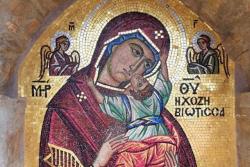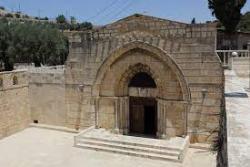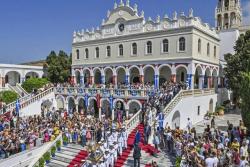Dormition of the Panaghia
 The celebration of the Dormition of the Panaghia in Greece, on the 15th of August, has a special place in the Orthodox calendar. Panaghia, as the Greeks call the most Holy Virgin Mary (Maria) gave birth to Our Lord Jesus Christ. Known in Greek as Kimisis tis Theotokou or Dekapentavousto, this major annual celebration is linked to the Mother of God. Most religious Greeks honour and respect her more than any other holy person, including the saints and the twelve apostles. The special adoration that Greeks have for the Virgin Mary is evident all around the country. There are innumerable churches and chapels across Greece named after the Panaghia (the Most Holy One) including Aghia Panaghia in the Old Village of Ermioni, where the main divine church liturgies and religious celebrations are held.
The celebration of the Dormition of the Panaghia in Greece, on the 15th of August, has a special place in the Orthodox calendar. Panaghia, as the Greeks call the most Holy Virgin Mary (Maria) gave birth to Our Lord Jesus Christ. Known in Greek as Kimisis tis Theotokou or Dekapentavousto, this major annual celebration is linked to the Mother of God. Most religious Greeks honour and respect her more than any other holy person, including the saints and the twelve apostles. The special adoration that Greeks have for the Virgin Mary is evident all around the country. There are innumerable churches and chapels across Greece named after the Panaghia (the Most Holy One) including Aghia Panaghia in the Old Village of Ermioni, where the main divine church liturgies and religious celebrations are held.
 The Dormition of Panaghia is not a mounful event for Greek Orthodox Christians, instead, it is a joyous celebration, because the Vigin 'transcended to eternal life'. The Catholic Church believes in the doctrine of the bodily assumption of the Virgin Mary, this was finalised in 1950 by the constitution of Pope Pius XII. In contrast, the Orthodox Church proclaimes the Dormition of the Panaghia, meaning her real death, separation of body and soul. The first testimonies about the celebration of the Dormition of Panaghia appear in the 5th century AD, at a time when the Holy Mother of God was first celebrated in Gethsemane, in the holy city of Jeusalem, where the Tomb of the Virgin Mary is located. A magnificent church was built over the Virgin's Tomb that exists today, attracting many Christians from around the world.
The Dormition of Panaghia is not a mounful event for Greek Orthodox Christians, instead, it is a joyous celebration, because the Vigin 'transcended to eternal life'. The Catholic Church believes in the doctrine of the bodily assumption of the Virgin Mary, this was finalised in 1950 by the constitution of Pope Pius XII. In contrast, the Orthodox Church proclaimes the Dormition of the Panaghia, meaning her real death, separation of body and soul. The first testimonies about the celebration of the Dormition of Panaghia appear in the 5th century AD, at a time when the Holy Mother of God was first celebrated in Gethsemane, in the holy city of Jeusalem, where the Tomb of the Virgin Mary is located. A magnificent church was built over the Virgin's Tomb that exists today, attracting many Christians from around the world.
Celebrations in Ermioni begin with an evening service on the 14th August in the Panaghia church in the Old Village. This service is followed by the Epitaphios funeral bier being carried in procession through the streets of the Old Village, down to the war memorial at the Limani waterfront. After a short blessing, the procession returns to the Panaghia church for further prayers and the distribution of blessed bread by the Ermioni priests. The following day a morning service is held in the Panaghia church, followed by holy communion for the faithful. As the congregation return home with family and friends, preparations are made for celebrating the national holiday and nameday in the form of feasting, drinking, singing and dancing. Celebrations continue throughout the day and night, some finishing the next day.
 The Greek island of Tinos is traditionally the focus of celebrations for the annual feast of the Dormition, with the faithful making pilgrimages to the majestic Church of the Virgin Mary of Tinos. The icon naming the church was found in January 1823 by a nun at the historic Monastery of the Dormition of the Virgin (Lady of Angels) on the island, who was directed to its location by the Virgin. The annual liturgy is celebrated on the same day commemorating the sinking of the Hellenic cruiser 'Elli' at the island port by the Italians on Dormition Day on 15th August 1940. Both events are attended annually by the high government and armed forces leaders. For Greeks, the Panaghia has been strongly connected to the historical struggles of the nation, particularly the revolutions and wars of the 19th and 20th centuries.
The Greek island of Tinos is traditionally the focus of celebrations for the annual feast of the Dormition, with the faithful making pilgrimages to the majestic Church of the Virgin Mary of Tinos. The icon naming the church was found in January 1823 by a nun at the historic Monastery of the Dormition of the Virgin (Lady of Angels) on the island, who was directed to its location by the Virgin. The annual liturgy is celebrated on the same day commemorating the sinking of the Hellenic cruiser 'Elli' at the island port by the Italians on Dormition Day on 15th August 1940. Both events are attended annually by the high government and armed forces leaders. For Greeks, the Panaghia has been strongly connected to the historical struggles of the nation, particularly the revolutions and wars of the 19th and 20th centuries.
The 15th of August is also a very special nameday in Greece. Women named Maria, Mary or Panagiota, whose names are related to the Most Holy Mother, have their nameday. Maria is still the most common name in Greece. Men who go by the name of Marios or Panagiotis also celebrate their nameday on the same day. These celebrations are accompanied by traditional local fiestas in many cities, towns and villages, known in Greek as Panigiria. The 15th of August is a Greek national public holiday, so many shops and businesses will be closed. Ancient sites, museums, restaurants, tavernas, cafes and bars will remain open for the special day.